U.S. Army—Blending EW + Cyber Warfare On The Battlefield
As new technologies emerge and new cyber and electronic warfare threats plague Soldiers in the field, U.S. Army scientists and engineers continue to define next-generation protocols and system architectures to help develop technology capabilities to combat these threats in an integrated and expedited fashion.

The U.S. Army RDECOM CERDEC Integrated Cyber and Electronic Warfare, or ICE, program looks to leverage both cyber and Electronic Warfare capabilities as an integrated system to increase the commander’s situational awareness. CERDEC is focusing its science and technology efforts on researching solutions to address specific cyber and Electronic Warfare threats and developing the architecture onto which scientists and engineers can rapidly develop and integrate new and more capable solutions. Image is courtesy of U.S. Army CERDEC.
As part of the Integrated Cyber and Electronic Warfare, or ICE, program, the U.S. Army Research, Development and Engineering Command’s Communications-Electronics Center, known as CERDEC, researches the technologies, standards and architectures to support the use of common mechanisms used for the rapid development and integration of third-party cyber and electronic warfare, or EW, capabilities.
“Currently, within cyber and EW disciplines there are different supporting force structures and users equipped with disparate tools, capabilities and frameworks,” said Paul Robb Jr., chief of CERDEC Intelligence and Information Warfare Directorate’s Cyber Technology Branch.
“Under the ICE program, we look to define common data contexts and software control mechanisms to allow these existing frameworks to communicate in a manner that would support the concurrent leveraging of available tactical capabilities based on which asset on the battlefield provides the best projected military outcome at a particular point in time,” said Robb.
The boundaries between traditional cyber threats, such as someone hacking a laptop through the Internet, and traditional EW threats, such as radio-controlled improvised explosive devices that use the electromagnetic spectrum, have blurred, allowing EW systems to access the data stream to combat EW threats, according to Giorgio Bertoli, senior engineer of CERDEC I2WD’s Cyber/Offensive Operations Division. Additionally, significant technological advancements including a trend towards wireless in commercial applications and military systems have occurred over the last decade, said Bertoli.
“This blending of networks and systems, known as convergence, will continue and with it come significant implications as to how the Army must fight in the cyber environment of today and tomorrow,” said Bertoli.
“The concept of technology convergence originated as a means to describe the amalgamation of traditional wired versus wireless commercial services and applications, but has recently evolved to also include global technology trends and U.S. Army operational connotations—specifically in the context of converging cyber and EW operations,” said Bertoli.
The Army finds itself in a unique position to help mitigate adverse outcomes due to this convergence trend.
“Post-force deployment, the Army has the vast majority of sensors and EW assets on the tactical battlefield compared to any other service or organization, posing both risks and opportunities. Our military’s reliance on COTS [commercial-of-the-shelf] systems and wireless communications presents a venue for our adversaries to attack. Conversely, the proximity and high density of receivers and transmitters that we deploy can be leveraged to enable both EW and cyber operations,” said Bertoli.
“The ability to leverage both cyber and EW capabilities as an integrated system, acting as a force multiplier increasing the commander’s situational awareness of the cyber electromagnetic environment, will improve the commander’s ability to achieve desired operational effects,” said Robb.
A paradigm shift in how the Army views system and technology development will further enhance CERDEC’s ability to rapidly adapt to new cyber and EW threats.
“The biggest hindrance we have right now is not a technological one, it’s an operational and policy one,” said Bertoli. “The Army traditionally likes to build systems for a specific purpose —build a radio to be a radio, build an EW system to be an EW system,—but these hardware systems today have significantly more inherent capabilities.”
To demonstrate the concepts of multi-capability systems, CERDEC chose not to solely focus its science and technology efforts on researching solutions to address specific cyber and EW threats, but also to develop the architecture onto which scientists and engineers can rapidly develop and integrate new, more capable solutions.
“As an example, the World Wide Web has grown into an architecture that is so powerful your tech savvy 10-year-old can build a website—and a pretty powerful one at that,” said Bertoli. “The only reason this is possible is because there is a wealth of common tools, like web browsers and servers, and standards such as HTML or HTTP already in place for them to use.”
“The ICE program is attempting to extend this model to the cyber and EW community by providing mechanisms to enable the leveraging of available tactical assets to support cyberspace operation mission sets. Early focus revolves around the development of augmented situation-awareness capabilities but will evolve to include the enabling of a multitude of cyberspace operations,” said Bertoli.
ICE will provide the Army with common tools and standards for developing and integrating cyber and EW capabilities.
“Capabilities can be developed to combat EM (electromagnetic) and cyber threats individually, but this is neither time nor cost effective and simply will not scale in the long term. The domain is just too large and will only continue to expand,” said Bertoli.
“In the end, we (CERDEC) believe this is the only way the Army will be able to keep pace with the anticipated technology advancements and rate of change related to cyberspace and the systems that comprise it,” said Bertoli.
The Army acquisition community has also seen changes in the relationship between cyber and EW.
“Tactical EW systems and sensors provide for significant points of presence on the battlefield, and can be used for cyber situational awareness and as delivery platforms for precision cyber effects to provide a means of Electronic Counter Measures and Electronic Counter-Counter Measures, for instance,” said Col. Joseph Dupont, program manager for EW under Program Executive Office Intelligence, Electronic Warfare and Sensors.
“There is no doubt in my mind that we must provide for a more integrated approach to cyber warfare, electronic warfare and electromagnetic operations to be successful in the future conduct of unified land operations,” said Dupont.
CERDEC, as the Army’s research and development experts in cyber and EW, works closely with the Program Executive Offices, the Army’s Training and Doctrine Command and Army Cyber Command to shape operational concepts and doctrine by providing technical expertise regarding technically achievable solutions in the context of the tactical cyberspace operations and supporting materiel capabilities for the Army.
In addition to working with the Army’s strategy and policy makers, CERDEC I2WD has tapped into its facilities and pre-existing expertise to further the ICE program.
CERDEC I2WD maintains state-of-the-art laboratories that support both closed and open-air testing facilities to provide relevant environment conditions to conduct research that provides a seamless cyber-electromagnetic environment with both wired and wireless modern communication infrastructure.
“We leverage these facilities and our inherent core competencies in cyber, EW and signals intelligence to engage with the Army and the community at large, both academia and industry partners, to collaborate on developing and integrating relevant technologies to achieve domain superiority in a changing environment,” said Robb.
The fully-instrumented labs include commercial information assurance products and allow for in-depth experimentation while sustaining automated rapid network re-configuration technology and virtualization technologies to support scalable testing. Additionally, I2WD expands its potential environment by maintaining remote connections with external government sites, which also enables collaborative experiments.
The combination of these assets and expertise allows CERDEC to demonstrate achievable capability improvements related to cyber and EW convergence.
“During the next three years, the biggest thing we can do within the ICE effort is show the ‘art of the possible’ by providing technology demonstrations on both existing and experimental Army systems to provide concrete proof of the advantages such a capability can provide,” said Bertoli.
Story by Kristen Kushiyama, RDECOM CERDEC
* * * * * * * * *
Astrium + UK MOD—Terminals For Secure Comms
Astrium is now delivering to the UK Ministry of Defence (MOD) enhanced overseas tactical, land and maritime communications capability which directly links to Astrium Services’ new IP core based modular infrastructure.
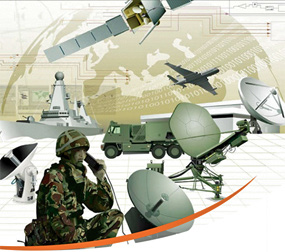
This capability allows UK Armed Forces to securely connect their users to one core defense infrastructure.
That single core will support all voice and data traffic with encryption from tactical, land and maritime operations across the globe—rather than having to recreate a network of services.
Astrium Services is delivering the first two DMM (Deployable Maritime Milsat) SCOTPatrol terminals, which feature reduced top-weight and a compact footprint both above and below deck for easier integration on small vessels.
These terminals will enable IP based communication onboard smaller Royal Navy ships, including Mine Counter Measure Vessels on operations in the Arabian Gulf. The SCOTPatrol next generation naval satellite communications terminal, along with all of the baseband equipment, allow the vessels to fully integrate into the network via Skynet 5’s resilient and hardened X-band satcoms. Further terminals are on order and are being delivered during the next year.
To meet the UK Armed Forces land and tactical requirements, Astrium Services is delivering 25 Mantis terminals and lightweight “Snapper” baseband equipment to the UK MOD as part of a managed service package.
A small IP node service—which has enabled a switch over to IP baseband—covers X-band on Skynet 5, a Mantis terminal and “Snapper” baseband for an advanced lightweight and resilient communications capability for remote users overseas.
To meet the requirements of large deployed land forces or air bases with multiple users, fixed and transportable IP Domain nodes are available. The first two overseas bases to be equipped are on order for delivery early next year.
Services offered as part of the Skynet 5 contract also cover training, spares/maintenance support, assurance monitoring and reporting, as well as 24/7 customer services and more.
Through the Skynet program, Astrium Services operates the Skynet military satellite constellation and the ground network to provide all Beyond Line of Sight communications to the UK MOD.
The program, covering a 22-year period, has also enabled Astrium Services to provide Skynet-based communication services to other government institutions including the UK Cabinet Office and armed forces from other nations such as The Netherlands and Portugal, and also to NATO.
* * * * * * * * *
Air Force Association—Cybersecurity Competition

The Air Force Association has announced that CyberPatriot, the National Youth Cyber Defense Competition, has drawn 1,566 teams for its sixth season of competition, representing a nearly 30 percent growth from last year.
This year, teams represent all 50 states, the District of Columbia, Puerto Rico, Canada, and U.S. Department of Defense Dependent Schools in Germany, Italy, The Republic of Korea, and Japan. New to the competition this year is a middle school division featuring 69 middle school teams from 23 states. This new pilot track is being offered in response to an increase in interest among younger students in the cybersecurity and STEM fields.
Teams are now gearing up for the first online round of competition, which will be held November 15-17. This round uses the CyberPatriot Competition System developed by the Center for Infrastructure Assurance and Security (CIAS) at the University of Texas at San Antonio, to allow hundreds of teams to compete at the same time. During the round, teams compete online to identify and solve vulnerabilities in simulated computer networks.
Combined scores from this round and a second online round in December will determine which teams advance to the Semifinals where they will have a chance to win all-expenses-paid trips to the National Finals Competition in Washington, D.C. in March 2014.
For teams not advancing to the CyberPatriot National Finals Competition, a state and regional recognition round will be held to determine top teams in each area that were not national finalists. The Regional Recognition Round will be powered by Leidos’ CyberNEXS.
“CyberPatriot is the nation’s largest and fastest growing youth cybersecurity challenge,” said Bernie Skoch, CyberPatriot Commissioner. “Its unique structure allows us to provide a hands-on learning environment that engages students in the curriculum and excites them through the element of competition. We are particularly excited this year to bring personal and professional growth for middle school participants by teaching them technical skills as well as the value of teamwork, leadership, and critical-thinking, right alongside high school students.”
CyberPatriot is presented by the Northrop Grumman Foundation, with founding partners SAIC and the CIAS at the University of Texas at San Antonio. Other sponsors include Cyber Diamond Sponsors AT&T Federal, Cisco, Microsoft, Raytheon, USA Today, the U.S. Department of Homeland Security, the Office of the Secretary of Defense; Cyber Gold Sponsors URS, Splunk, and Symantec; and Cyber Silver Sponsors Air Force Research Laboratory, Embry-Riddle Aeronautical University, Leidos, MIT Lincoln Laboratory, and University of Maryland University College.
The Air Force Association is a non-profit, independent, professional military and aerospace education association. Our mission is to promote a dominant United States Air Force and a strong national defense, and to honor Airmen and our Air Force Heritage.
AFA has 200 chapters nationally and internationally representing more than 107,000 members.
More information on this competition is available at: http://www.uscyberpatriot.org/Pages/default.aspx
* * * * * * * * *
U.S. Army—Continuing The Drive For Innovation
After putting the tactical communications network “under pressure” in a realistic operational environment in order to quickly deliver a “digital guardian angel” to troops in Afghanistan, Army leaders said the Network Integration Evaluation process is adapting to drive continued innovation.
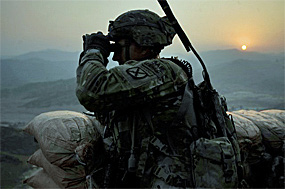
Staff Sgt. Shelby Johnson, a squad leader with the 4th Brigade Combat Team, 10th Mountain Division (Light Infantry), observes the area around Forward Operating Base Torkham, Afghanistan, while wearing the new Capability Set 13 communications suite. Photo courtesy of U.S. Army.
The network remains a critical modernization priority in today’s uncertain budget and national security climate, senior leaders said this week, during the 2013 Association of the United States Army Annual Meeting and Exposition.
With Capability Set 13, or CS 13, now supporting long-range, on-the-move communications for two brigade combat teams of the 10th Mountain Division during their advise-and-assist operations, the Army is focused on improving future capability sets by promoting competition among vendors and simplifying the network for the user.
“As the Army gets smaller, the network is an enabler to that smaller force—it makes it more lethal, it gives it a greater reach,” said Col. Mark Elliott, director of the Army’s G-3/5/7 LandWarNet-Mission Command Directorate. “You do get more bang for your buck for what the network brings to the Warfighter—we just have to continue to do it better.”
Leveraging lessons-learned from the 10th Mountain Division (Light Infantry) and the semi-annual Network Integration Evaluations, known as NIEs, the Army is working to enhance training and make systems more user-friendly as additional brigade combat teams are fielded with advanced network capabilities.
Aside from the operational benefits, simplifying the network will lead to cost savings by combining hardware and other infrastructure, reducing software development efforts and decreasing the number of field service representatives required to train Soldiers and troubleshoot systems.
“This network allows the commander to stay in the situation, to stay connected, at all times—that’s what the power of the network is,” said Brig. Gen. Dan Hughes, program executive officer for Command, Control and Communications-Tactical, or PEO C3T. “But we have to make these systems much easier to use, train and maintain.”
As the Army transitions from fighting two wars to preparing for future threats, the NIE will provide the operational “laboratory” to incrementally enhance the network, respond to the emerging needs of regionally aligned forces and assess dynamic “leap-ahead” technologies, leaders said.
While the events are adapting due to budget constraints—including greater use of modeling and simulation—the Army remains committed to the forum and the construct.
“Continued evaluation of new capabilities for the future is essential—how can we afford not to do it?” said Lt. Gen. Keith Walker, director of the Army Capabilities Integration Center. “The NIE gives us a practical, hands-on environment to develop programs in real time with Soldier feedback.”
Over the course of the five NIEs conducted to date, such user feedback not only shaped the technology and doctrine for CS 13, but also influenced the Army’s acquisition strategy on several key programs, including tactical radios, said Heidi Shyu, assistant secretary of the Army for Acquisition, Logistics and Technology.
“The NIE has informed us that we have more vendors out there that can come into competitive environments and produce the innovation we need,” Hughes said.
While the Army has procured commercial routers, antennas, switches and other items as part of the NIE, the service is also implementing changes to improve the process for industry partners.
Capability gaps will be identified farther in advance and “locked” in place to be evaluated over two NIE cycles, increasing industry’s lead time in developing mature capability solutions.
Having fewer, more defined gaps will also allow the Army to better align NIE results with budget planning to inform procurement and fielding decisions for future capability sets, Elliott said.
NIE 14.1, the sixth event in the series, begins next week and continues through November. By mixing live and simulated operations, NIE 14.1 will reduce cost and demonstrate innovative training techniques and capabilities.
Next spring, NIE 14.2 will be the first such event to include joint and multi-national participation. NIE 15.1, in fall 2014, will be used to assess the integrated network baseline to evaluate the performance of existing network capabilities and identify remaining gaps for industry to target.
“[The NIE] is not a one-year, two-year or three-year journey,” said Lt. Gen. James Barclay III, deputy chief of staff, Army G-8. “This is a long-term journey to help us decide where we want to go, what we need to buy, or what we need to improve.”
(Nancy Jones-Bonbrest contributed to this article.)
Story by Claire Heininger, U.S. Army
* * * * * * * * *
Harris—Falcon III Flies To The Middle East
Harris Corporation has received an $11 million order from a Middle Eastern nation to provide a comprehensive coastal intelligence, surveillance and reconnaissance communications network.
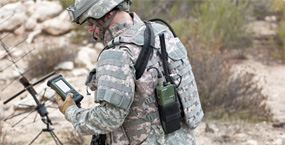
Harris will provide Falcon III® RF-7800M Multiband Networking Radios, accessories and its battle management application in Coast Guard vehicles and strategic installations on land, at sea and in the air.
The integrated solution will allow users to send and receive situational awareness and intelligence information across a secure mobile network, connecting squads and their commanders for real-time decision-making. If a threat is detected, local commanders will be able to coordinate air, ground and naval asset responses.
“This unique solution demonstrates Harris’ ability to deliver integrated tactical area communication systems that connect users wherever they are,” said Brendan O’Connell, president, International Business, Harris RF Communications. “Users will be able to communicate over longer distances and reach command centers from remote areas that lack telecommunications infrastructure.”
The RF-7800M is part of the Falcon III® family of wideband radios. Harris has shipped more than 45,000 of the radios to the U.S. Department of Defense as well as allied forces in more than 15 nations.
Harris RF Communications is the leading global supplier of secure radio communications and embedded high-grade encryption solutions for military, government and commercial organizations.
Falcon III® is the next generation of radios supporting the U.S. military’s Joint Tactical Radio System (JTRS) requirements, as well as network-centric operations worldwide.
Harris RF Communications is also a leading supplier of assured communications® systems and equipment for public safety, utility and transportation markets—with products ranging from the most advanced IP voice and data networks to portable and mobile single and multiband radios.
* * * * * * * * *
Northrop Grumman + U.S. Navy—First Flight Faultless
Northrop Grumman Corporation and the U.S. Navy have successfully completed the first flight of the next-generation MQ-8C Fire Scout unmanned helicopter at Naval Base Ventura County, Point Mugu, California.
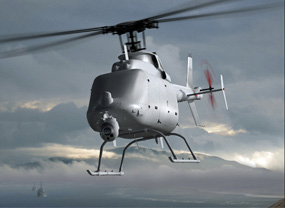
The MQ-8C Fire Scout is a fully autonomous, four- blade, single-engine unmanned helicopter. Image courtesy of Northrop Grumman.
The MQ-8C Fire Scout took off and flew for seven minutes in restricted airspace to validate the autonomous control systems. A second flight was also flown in a pattern around the airfield, reaching 500 feet altitude.
The aircraft was operated by a ground-based Navy/Northrop Grumman flight test team also located at Naval Base Ventura County.
“First flight is a critical step in maturing the MQ-8C Fire Scout endurance upgrade before using the system operationally next year,” said Capt. Patrick Smith, Fire Scout program manager, Naval Air Systems Command. “The systems we’ve developed to allow Fire Scout to operate from an air-capable ship have already amassed more than 10,000 flight hours with the MQ-8B variant. This system’s evolution enhances how unmanned air systems will support maritime commanders.”
The MQ-8C Fire Scout is designed to fly twice as long and has three times the payload capacity of the current MQ-8B variant.
Based on a larger commercial airframe with additional fuel tanks and an upgraded engine, the MQ-8C will be able to fly up to 12 hours or carry up to 2,600 pounds.
“Operating the MQ-8B Fire Scout from Navy ships has proved extremely successful. During at-sea deployments, operators saw the need for a system that carried the same intelligence-gathering capabilities of the MQ-8B, but fly longer and carry additional payloads,” said George Vardoulakis, Northrop Grumman’s vice president for medium range tactical systems. “Changing out the airframe, installing control systems and avionics, and then conducting a first flight of the system in a year is truly remarkable. I couldn’t be more proud of the team.”
Currently, the MQ-8B Fire Scout is on its seventh at-sea deployment supporting antipiracy missions on board Navy frigates. The system has also been used extensively in Afghanistan since early 2011 to provide airborne surveillance to ground commanders.
Using on-board sensors to capture full-motion video, Fire Scout can identify targets and then distribute the information in real time to various users. This capability allows ship-based commanders to maintain awareness of a specified area or keep an eye on a target of interest for long periods of time.
Production of the MQ-8C Fire Scout is being completed at the Northrop Grumman Unmanned Systems Center in Moss Point, Mississippi.
The MQ-8C Fire Scout industry team includes Bell Helicopter, Rolls-Royce, Summit Aviation, Cubic Corporation, General Electric Aviation, Sierra Nevada Corporation and Honeywell.
* * * * * * * * *
U.S. Army—Evaluating The TCN System
Soldiers of Bravo Company, 2nd Special Troops Battalion, 1st Armored Division, are evaluating a plethora of new equipment for the Brigade Modernization Command during the Network Integration Evaluation 14.1.
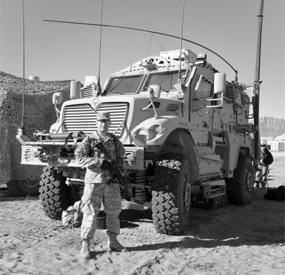
Cpl. Marc Harms, a signal support specialist in Headquarters, Headquarters Company, 2nd Brigade, 1st Armored Division, guards the only Mobile Integrated Command Post MaxxPro mine-resistant, ambush-protected vehicle in the Army at Fort Bliss, Texas, October 28, 2013. Harms evaluates the MICP MRAP during Network Integration Evaluation 14.1. (U.S. Army photo by Staff Sgt. Kulani J. Lakanaria)
The equipment being evaluated is an upgraded version of the tactical communications node or TCN.
“The tactical communications node is important because it gives our brigade commander on-the-move communication capabilities,” said Sgt. Lindsay Szopinski, a tactical communications team chief in Bravo Company, 2/1 STB. “The TCN also can provide stationary capabilities.”
The TCN system is designed to provide a satellite and terrestrial communication network. Additionally, the service allows soldiers to send and receive information in a tactical environment. The system also can provide a mobile, flexible, dynamic tactical network capable of support for a highly dispersed force over an isolated area.
“The system includes a satellite terminal transportable, network to network central waveform, division multiple access and line of sight communications,” Szopinski said. “The line of sight communications can reach 32 kilometers.”
The TCN can work like an Internet access point in an austere environment.
“I think it is also a morale booster,” said Spc. Ricky Anggana, a satellite communications system operator in Bravo Company, 2/1 STB. “The system can get voice and data including social media sites. It is also important to keep soldiers connected with family. Normally we don’t get to work with this system. I can’t wait to see how it preforms during the rest of the [Network Integration Evaluation 14.1].”
The TCN system is fully mobile. It can be set up, broken down and moved to a new area rapidly.
“The TCN network enhances signal capabilities on a new battlefield,” Szopinski explained. “It’s important because it provides ungrounded communications. To sum it up it’s [Internet] and communications on the go.”
Story by Staff Sgt. Kulani Lakanaria, 24th Press Camp Headquarters, Fort Bliss, Texas







